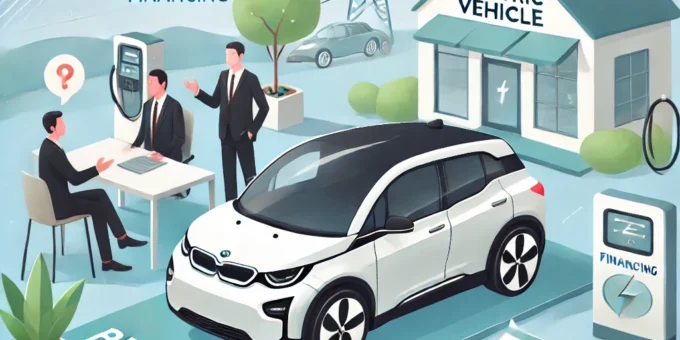
Electric vehicles (EVs) are becoming increasingly popular, offering eco-friendly benefits, lower running costs, and cutting-edge technology. However, if you’re considering buying your first EV, the higher upfront cost compared to traditional cars may seem daunting. The good news? Financing your first electric vehicle is more straightforward and affordable than you might think, thanks to incentives, green loans, and leasing options tailored for EVs.
In this beginner’s guide, we’ll walk you through everything you need to know about financing your first EV. From understanding loans and incentives to creating a realistic budget, you’ll be equipped to make an informed and confident decision.
Introduction
Owning an electric vehicle is an exciting step towards a more sustainable lifestyle. But let’s face it—EVs often come with a higher initial price tag, making financing a key consideration for most first-time buyers.
The good news is that the EV market has matured, with lenders, manufacturers, and governments offering attractive incentives to make your first EV more accessible. With careful planning and smart financing, you can drive your dream electric car while keeping costs under control.
Why Financing an EV Is Different from Traditional Cars
- Higher Upfront Costs: EVs often have higher purchase prices due to advanced technology and battery systems.
- Incentives and Rebates: EV buyers can take advantage of government incentives to reduce the effective cost.
- Lower Running Costs: Savings on fuel, maintenance, and repairs offset the initial expense over time.
- Special Financing Options: Green loans and exclusive programs for EVs make financing more affordable.
Steps to Finance Your First Electric Vehicle
1. Determine Your Budget
Before diving into financing options, start by setting a realistic budget:
- Down Payment: Aim for 10%-20% of the vehicle’s cost upfront to reduce loan amounts.
- Monthly Payments: Consider how much you can afford to pay each month without straining your finances.
- Additional Costs: Include insurance, taxes, and charging equipment in your calculations.
Use an online car loan calculator to estimate your monthly payments based on loan amount, term, and interest rate.
2. Understand EV Incentives and Tax Credits
One of the biggest advantages of buying an EV is the range of incentives available:
- Federal Tax Credit: The U.S. federal government offers up to $7,500 for eligible EVs.
- State and Local Rebates: Check for additional rebates, tax exemptions, or grants in your area.
- Utility Rebates: Some power companies provide discounts on EV purchases or charging station installations.
Pro Tip: Combine federal and state incentives to maximize your savings. Use resources like the U.S. Department of Energy’s website to check eligibility.
3. Explore EV Financing Options
There are multiple financing options available for first-time EV buyers:
Traditional Auto Loans
- Offered by banks, credit unions, and online lenders.
- Fixed interest rates, typically between 3%-7%, depending on your credit score.
Green Auto Loans
- Specifically designed for EV and hybrid vehicles.
- Often feature lower interest rates and exclusive terms to encourage sustainable choices.
Manufacturer Financing Programs
- Automakers like Tesla, Hyundai, and Nissan offer in-house financing.
- May include promotional rates (e.g., 0% APR) or cashback deals for EVs.
Leasing
- A cost-effective way to drive an EV without long-term ownership.
- Lower monthly payments compared to loans, with the option to buy the car at the end of the lease.
4. Compare Loan Offers
Shop around for the best financing deals:
- Credit Unions: Often provide competitive rates for auto loans, including green loans.
- Online Lenders: Quick application processes and easy rate comparisons.
- Dealership Financing: Convenient but not always the lowest rate—compare offers with banks.
Pro Tip: Get pre-approved for a loan to know your limits before negotiating with dealers.
5. Factor in Charging Infrastructure Costs
Installing a home charging station is an additional expense, but many incentives can help:
- Level 1 Charger: Included with most EVs but slower charging times.
- Level 2 Charger: Costs $500-$2,000, depending on installation requirements.
- Incentives: Federal and state programs may subsidize home charging equipment costs.
Pro Tip: Research public charging networks like Tesla Superchargers or ChargePoint to complement home charging.
Benefits of Financing an EV
- Affordable Ownership: Spread the cost over manageable monthly payments.
- Immediate Savings: Start saving on fuel and maintenance costs from day one.
- Eco-Friendly Loans: Benefit from lower interest rates on green auto loans.
- Upgrade Options: Leasing allows you to switch to newer EV models every few years.
Common Mistakes to Avoid
- Ignoring Incentives: Many first-time buyers overlook valuable rebates and tax credits.
- Not Researching Loan Options: Compare multiple offers to ensure you’re getting the best rate.
- Underestimating Costs: Factor in charging equipment, insurance, and taxes when budgeting.
- Focusing Only on Price: Consider long-term savings on fuel and maintenance rather than just the upfront cost.
- Skipping a Test Drive: Ensure the EV meets your driving needs and lifestyle before committing.
How to Maximize Savings on Your First EV
- Negotiate the Price: Research market prices and leverage dealer discounts.
- Combine Incentives: Use federal, state, and local rebates to reduce the total cost.
- Opt for Certified Pre-Owned EVs: Save money while enjoying warranty coverage and lower depreciation.
- Choose the Right Model: Consider EVs with high efficiency and lower battery degradation rates.